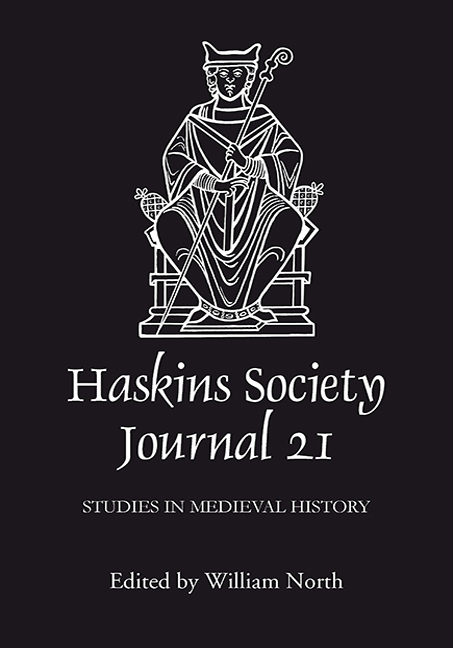Book contents
- Frontmatter
- Contents
- Editor's Note
- Abbreviations
- 1 Bede and the Rewriting of Sanctity
- 2 The Role of Rivers and Coastlines in Shaping Early English History
- 3 Containing Virginity: Sex and Society in Early Medieval England
- 4 Pagans and Infidels, Saracens and Sicilians: Identifying Muslims in the Eleventh-Century Chronicles of Norman Italy
- 5 Robert Curthose and the Norman Episcopate
- 6 The Revival of Roman Law: the Exceptiones Petri
- 7 Mutatis Mutandis: Literary Borrowing from Jerome's Letter to Eustochium and Others in the Life of Blessed Bernard of Tiron by Geoffrey Grossus
- 8 Acting Out Friendship: Signs and Gestures of Aristocratic Male Friendship in the Twelfth Century
- 9 The Quantification of Assarted Land in Mid- and Late Twelfth-Century England
- 10 Origins of Courtliness after 25 Years
5 - Robert Curthose and the Norman Episcopate
Published online by Cambridge University Press: 28 April 2017
- Frontmatter
- Contents
- Editor's Note
- Abbreviations
- 1 Bede and the Rewriting of Sanctity
- 2 The Role of Rivers and Coastlines in Shaping Early English History
- 3 Containing Virginity: Sex and Society in Early Medieval England
- 4 Pagans and Infidels, Saracens and Sicilians: Identifying Muslims in the Eleventh-Century Chronicles of Norman Italy
- 5 Robert Curthose and the Norman Episcopate
- 6 The Revival of Roman Law: the Exceptiones Petri
- 7 Mutatis Mutandis: Literary Borrowing from Jerome's Letter to Eustochium and Others in the Life of Blessed Bernard of Tiron by Geoffrey Grossus
- 8 Acting Out Friendship: Signs and Gestures of Aristocratic Male Friendship in the Twelfth Century
- 9 The Quantification of Assarted Land in Mid- and Late Twelfth-Century England
- 10 Origins of Courtliness after 25 Years
Summary
If the career of Robert Curthose, duke of Normandy (1087–1106), has rightly been the subject of much recent reassessment, the bishops of the duchy remain one important aspect of his reign that has been largely overlooked. The Norman episcopal network, which occupied a place of singular significance during the reign of William the Conqueror, had, by the time of the battle of Tinchebray, been brought to the brink of near systemic collapse. For many twelfth-century chroniclers the blame for such a catastrophe rested squarely with Robert Curthose. In a well-known speech put into the mouth of Serlo, bishop of Sées (1091–1123), Orderic Vitalis suggested the duke had willingly allowed the church to be ‘trodden underfoot’ and utterly ruined by magnates such as Robert II de Bellême (1077–1112). While such testimony has justifiably been shown often to oversimplify the complexities faced by the duke, a number of important questions concerning the episcopate have yet to be answered satisfactorily. To what extent, for example, was Curthose directly responsible for the collapse of the episcopal network? Is it possible to discern a ducal policy towards the episcopate, as it is for the reign of his father, and can we establish what place the bishops of Normandy occupied within the ducal entourage? Most importantly, if it can be demonstrated that Curthose was directly responsible for the collapse of the secular church – an element critical to any medieval realm – to what extent can we continue to claim that he was an often competent ruler whose difficult career has been largely misrepresented by historians?
The answers to these questions are, of course, complicated by a number of factors. The first concerns the amount of source material that has survived for Curthose's reign. In contrast to the situation for his father, whose extant post-1066 Norman and Continental acta alone number well over a hundred, less than fifty ducal charters survive for Curthose's nineteen-year rule, with the majority dating from before the duke's departure on crusade in 1096. Although this corpus of evidence has traditionally been interpreted as indicative of the duke's administrative and political failings, scholars have recently argued for a more nuanced approach to such evidence, claiming that other factors may lie behind the apparent scarcity of ducal acta.
- Type
- Chapter
- Information
- The Haskins Society Journal 212009. Studies in Medieval History, pp. 87 - 112Publisher: Boydell & BrewerPrint publication year: 2010

